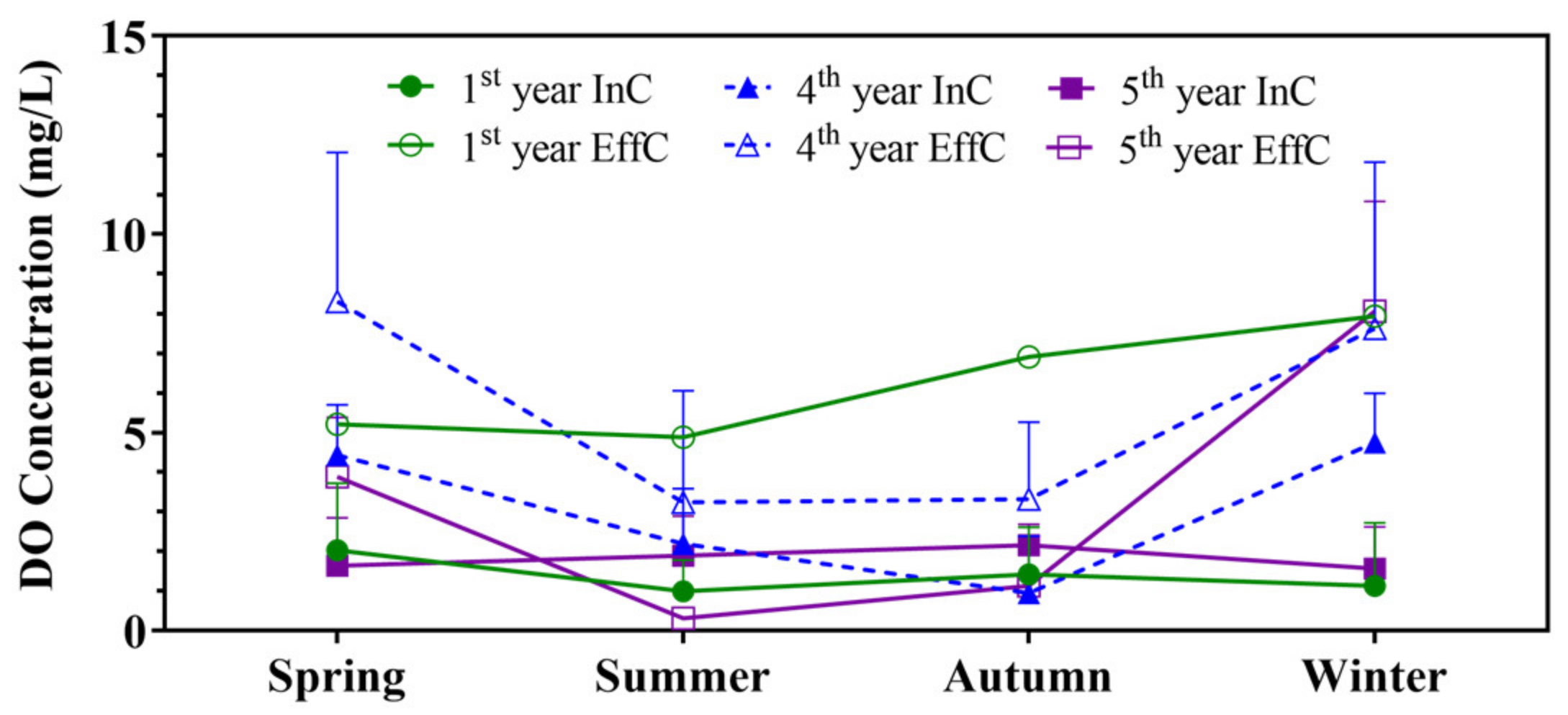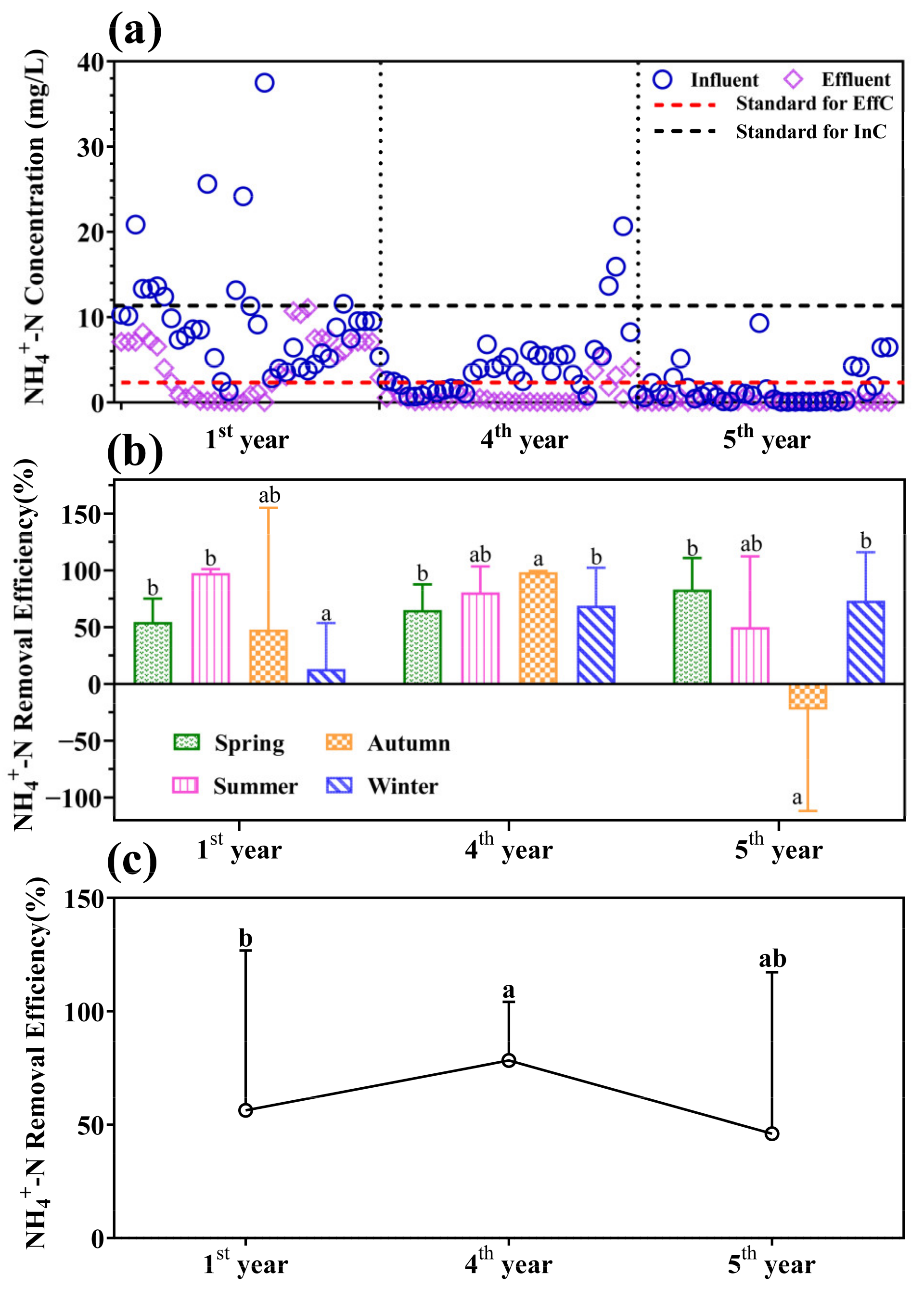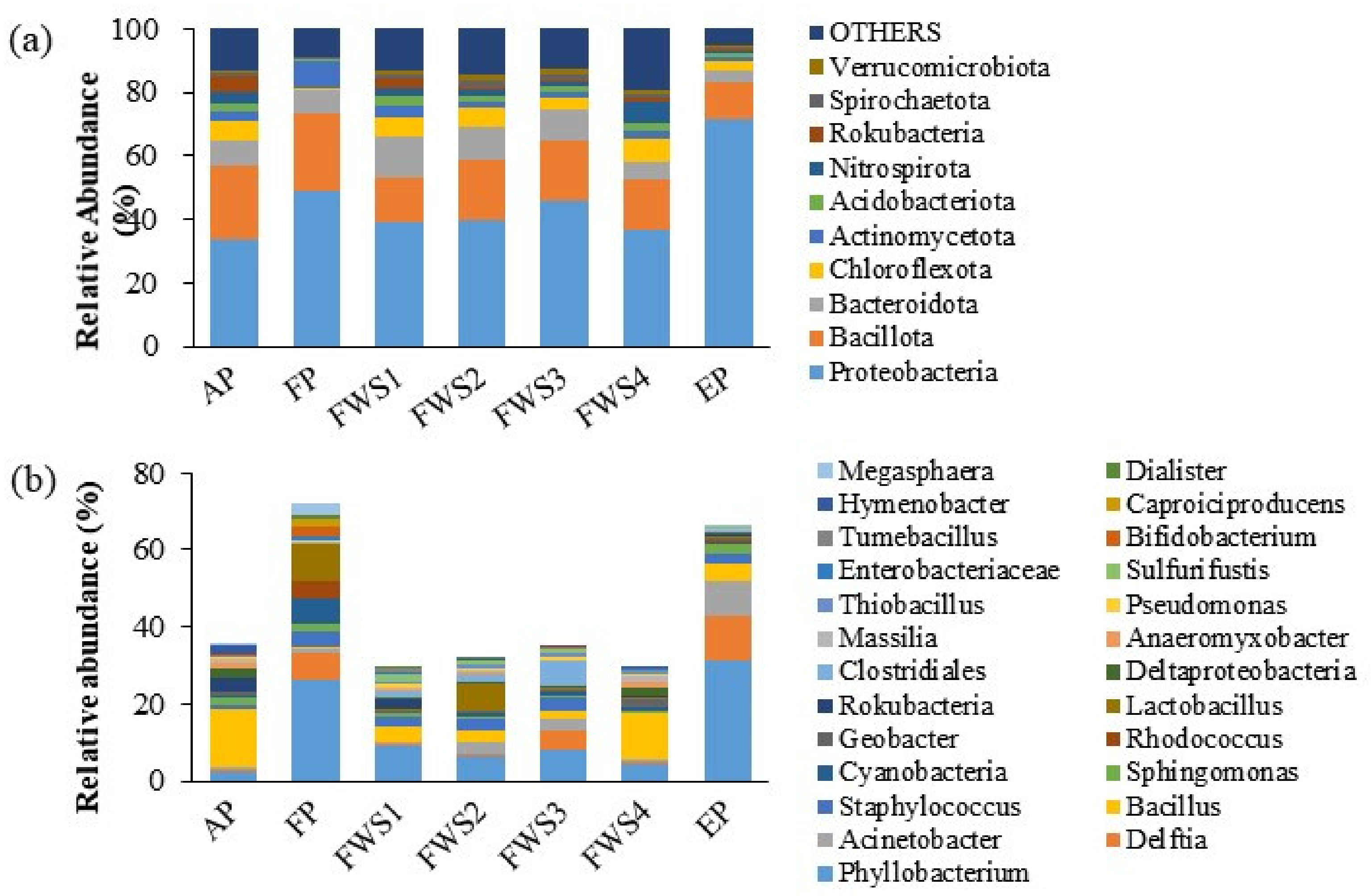Performance and Bacteria Communities of a Full-Scale Constructed Wetland Treating the Secondary Effluent after Multi-Years’ Operation
Abstract
1. Introduction
2. Materials and Methods
2.1. Site Description
2.2. Water Quality Monitoring
2.3. Microorganism Sampling and Analysis
2.4. Data Analysis
3. Results and Discussion
3.1. The Performance of HZ-CW after Years Operation
3.1.1. The DO Variations
3.1.2. The Performance for COD Removal
3.1.3. The Performance for NH4+-N Removal
3.1.4. The Performance for TP Removal
3.2. The Bacterial Communities Diversity and Composition in HZ-CW
3.2.1. The Richness and Diversity Analysis of the Bacterial Communities
3.2.2. Bacterial Community Composition
3.2.3. Bacteria Related to Nitrogen and Phosphorus Removal
4. Conclusions
Author Contributions
Funding
Data Availability Statement
Conflicts of Interest
References
- Vymazal, J. Constructed wetlands for wastewater treatment: Five decades of expericence. Environ. Sci. Technol. 2011, 45, 61–69. [Google Scholar] [CrossRef] [PubMed]
- Vymazal, J.; Brezinova, T. Long term treatment performance of constructed wetlands for wastewater treatment in mountain areas: Four case studies from the Czech Republic. Ecol. Eng. 2014, 71, 578–583. [Google Scholar] [CrossRef]
- Song, S.; Liu, B.; Zhang, W.; Wang, P.; Qiao, Y.; Zhao, D.; Yang, T.; An, S.; Leng, X. Performance of a large-scale wetland treatment system in treating tailwater from a sewage treatment plant. Mar. Freshw. Res. 2018, 69, 833–841. [Google Scholar] [CrossRef]
- Wu, H.; Zhang, J.; Guo, W.; Liang, S.; Fan, J. Secondary effluent purification by a large-scale multi-stage surface-flow constructed wetland: A case study in northern China. Bioresour. Technol. 2018, 249, 1092–1096. [Google Scholar] [CrossRef] [PubMed]
- Song, S.; Wang, P.; Liu, Y.; Zhao, D.; An, S. Effects of Oenanthe javanica on Nitrogen Removal in Free-Water Surface Constructed Wetlands under Low-Temperature Conditions. Int. J. Environ. Res. Public Health 2019, 16, 1420. [Google Scholar] [CrossRef]
- Zhao, D.; Zhang, M.; Liu, Z.; Sheng, J.; An, S. Can cold-season macrophytes at the senescence stage improve nitrogen removal in integrated constructed wetland systems treating low carbon/nitrogen effluent? Bioresour. Technol. 2018, 265, 380–386. [Google Scholar] [CrossRef]
- Gao, Y.; Zhang, W.; Gao, B.; Jia, W.; Miao, A.; Xiao, L.; Yang, L. Highly efficient removal of nitrogen and phosphorus in an electrolysis-integrated horizontal subsurface-flow constructed wetland amended with biochar. Water Res. 2018, 139, 301–310. [Google Scholar] [CrossRef]
- Vymazal, J. Constructed wetlands for wastewater treatment. Ecol. Eng. 2005, 25, 475–477. [Google Scholar] [CrossRef]
- Vymazal, J. Constructed wetlands for treatment of industrial wastewaters: A review. Ecol. Eng. 2014, 73, 724–751. [Google Scholar] [CrossRef]
- Morvannou, A.; Choubert, J.M.; Vanclooster, M.; Molle, P. Modeling nitrogen removal in a vertical flow constructed wetland treating directly domestic wastewater. Ecol. Eng. 2014, 70, 379–386. [Google Scholar] [CrossRef]
- Chen, S.K.; Jang, C.S.; Chou, C.Y. Assessment of spatiotemporal variations in river water quality for sustainable environmental and recreational management in the highly urbanized Danshui River basin. Environ. Monit. Assess. 2019, 191, 100. [Google Scholar] [CrossRef]
- Liu, D.; Ge, Y.; Chang, J.; Peng, C.; Gu, B.; Chan, G.Y.S.; Wu, X. Constructed wetlands in China: Recent developments and future challenges. Front. Ecol. Environ. 2009, 7, 261–268. [Google Scholar] [CrossRef]
- Zhang, D.Q.; Jinadasa, K.B.; Gersberg, R.M.; Liu, Y.; Ng, W.J.; Tan, S.K. Application of constructed wetlands for wastewater treatment in developing countries--a review of recent developments (2000–2013). J. Environ. Manag. 2014, 141, 116–131. [Google Scholar] [CrossRef]
- Li, X.; Li, Y.; Lv, D.; Li, Y.; Wu, J. Nitrogen and phosphorus removal performance and bacterial communities in a multi-stage surface flow constructed wetland treating rural domestic sewage. Sci. Total Environ. 2020, 709, 136235. [Google Scholar] [CrossRef]
- Zhu, T.; Gao, J.; Huang, Z.; Shang, N.; Gao, J.; Zhang, J.; Cai, M. Comparison of performance of two large-scale vertical-flow constructed wetlands treating wastewater treatment plant tail-water: Contaminants removal and associated microbial community. J. Environ. Manag. 2021, 278, 111564. [Google Scholar] [CrossRef]
- Cooper, D.; Griffin, P.; Cooper, P. Factors affecting the longevity of sub-surface horizontal flow systems operating as tertiary treatment for sewage effluent. Water Sci. Technol. 2005, 51, 127–135. [Google Scholar] [CrossRef]
- Nivala, J.; Rousseau, D.P.L. Reversing clogging in subsurface-flow constructed wetlands by hydrogen peroxide treatment: Two case studies. Water Sci. Technol. 2009, 59, 2037–2046. [Google Scholar] [CrossRef]
- Zhang, M.; Zhao, D.; Chen, C.; Yang, J.; Lu, Q.; Zhang, N.; Leng, X.; An, S. The effect of re-startup strategies on the recovery of constructed wetlands after long-term resting operation. Bioresour. Technol. 2020, 311, 123583. [Google Scholar] [CrossRef]
- Li, C.; Liu, Q.; Fan, J.; Peng, Y.; Du, R. Metagenomics-based interpretation of selective bioaugmentation promoting partial-denitrification coupling with anammox process reactivation in suspended sludge system. Chem. Eng. J. 2023, 454, 139977. [Google Scholar] [CrossRef]
- Wang, X.; Tian, Y.; Zhao, X.; Peng, S.; Wu, Q.; Yan, L. Effects of aeration position on organics, nitrogen and phosphorus removal in combined oxidation pond-constructed wetland systems. Bioresour. Technol. 2015, 198, 7–15. [Google Scholar] [CrossRef]
- Boog, J.; Nivala, J.; Aubron, T.; Wallace, S.; van Afferden, M.; Muller, R.A. Hydraulic characterization and optimization of total nitrogen removal in an aerated vertical subsurface flow treatment wetland. Bioresour. Technol. 2014, 162, 166–174. [Google Scholar] [CrossRef] [PubMed]
- Dong, H.; Qiang, Z.; Li, T.; Jin, H.; Chen, W. Effect of artificial aeration on the performance of vertical-flow constructed wetland treating heavily polluted river water. J. Environ. Sci. 2012, 24, 596–601. [Google Scholar] [CrossRef] [PubMed]
- Hu, N.; He, J.; Shi, W.; He, J.; Lv, B.; Liang, Y.; Huang, L. Ecological restoration for the Liangtan river by Rotating biological contactors combined with hybrid constructed wetlands. J. Clean. Prod. 2022, 375, 134189. [Google Scholar] [CrossRef]
- Kadlec, R.H.; Wallace, S. Treatment Wetlands, 2nd ed.; CRC Press Taylor & Francis Group: Boca Raton, FL, USA, 2009. [Google Scholar]
- Aiello, R.; Bagarello, V.; Barbagallo, S.; Iovino, M.; Marzo, A.; Toscano, A. Evaluation of clogging in full-scale subsurface flow constructed wetlands. Ecol. Eng. 2016, 95, 505–513. [Google Scholar] [CrossRef]
- Du, L.; Trinh, X.; Chen, Q.; Wang, C.; Wang, H.; Xia, X.; Zhou, Q.; Xu, D.; Wu, Z. Enhancement of microbial nitrogen removal pathway by vegetation in Integrated Vertical-Flow Constructed Wetlands (IVCWs) for treating reclaimed water. Bioresour. Technol. 2018, 249, 644–651. [Google Scholar] [CrossRef] [PubMed]
- Godos, I.; Vargas, V.A.; Blanco, S.; Gonzalez, M.C.; Soto, R.; Garcia-Encina, P.A.; Becares, E.; Munoz, R. A comparative evaluation of microalgae for the degradation of piggery wastewater under photosynthetic oxygenation. Bioresour. Technol. 2010, 101, 5150–5158. [Google Scholar] [CrossRef]
- Wu, Y.; Han, R.; Yang, X.; Zhang, Y.; Zhang, R. Long-term performance of an integrated constructed wetland for advanced treatment of mixed wastewater. Ecol. Eng. 2017, 99, 91–98. [Google Scholar] [CrossRef]
- Saggai, M.M.; Ainouche, A.; Nelson, M.; Cattin, F.; El Amrani, A. Long-term investigation of constructed wetland wastewater treatment and reuse: Selection of adapted plant species for metaremediation. J. Environ. Manag. 2017, 201, 120–128. [Google Scholar] [CrossRef]
- Wang, B.; Jiao, E.; Guo, Y.; Zhang, L.; Meng, Q.; Zeng, W.; Peng, Y. Investigation of the polyphosphate-accumulating organism population in the full-scale simultaneous chemical phosphorus removal system. Environ. Sci. Pollut. Res. Int. 2020, 27, 37877–37886. [Google Scholar] [CrossRef]
- Rousseau, D.P.L.; Horton, D.; Griffin, P.; Vanrolleghem, P.A.; Pauw, N.D. Impact of operational maintenance on the asset life of storm reed beds. Water Sci. Technol. 2005, 51, 243–250. [Google Scholar] [CrossRef]
- Ansola, G.; Arroyo, P.; Saenz de Miera, L.E. Characterisation of the soil bacterial community structure and composition of natural and constructed wetlands. Sci. Total Environ. 2014, 473–474, 63–71. [Google Scholar] [CrossRef]
- Wu, Y.; Han, R.; Yang, X.; Fang, X.; Chen, X.; Yang, D.; Zhang, R. Correlating microbial community with physicochemical indices and structures of a full-scale integrated constructed wetland system. Appl. Microbiol. Biotechnol. 2016, 100, 6917–6926. [Google Scholar] [CrossRef]
- Zhang, Y.; You, X.; Huang, S.; Wang, M.; Dong, J. Knowledge Atlas on the Relationship between Water Management and Constructed Wetlands—A Bibliometric Analysis Based on CiteSpace. Sustainability 2022, 14, 8288. [Google Scholar] [CrossRef]
- Zhang, Y.; Ji, Z.; Pei, Y. Nutrient removal and microbial community structure in an artificial-natural coupled wetland system. Process Saf. Environ. Prot. 2021, 147, 1160–1170. [Google Scholar] [CrossRef]
- Li, D.; Ye, B.; Hou, Z.; Chu, Z.; Zheng, B. Long-term performance and microbial distribution of a filed-scale storing multi-pond constructed wetland with Ottelia acuminata for the treatment of non-point source pollution. J. Clean. Prod. 2020, 262, 121367. [Google Scholar] [CrossRef]
- Li, H.; Liu, F.; Luo, P.; Chen, X.; Chen, J.; Huang, Z.; Peng, J.; Xiao, R.; Wu, J. Stimulation of optimized influent C:N ratios on nitrogen removal in surface flow constructed wetlands: Performance and microbial mechanisms. Sci. Total Environ. 2019, 694, 133575. [Google Scholar] [CrossRef]
- Fumasoli, A.; Morgenroth, E.; Udert, K.M. Modeling the low pH limit of Nitrosomonas eutropha in high-strength nitrogen wastewaters. Water Res. 2015, 83, 161–170. [Google Scholar] [CrossRef]
- Gao, J.; Zhu, T.; Liu, C.; Zhang, J.; Gao, J.; Zhang, J.; Cai, M.; Li, Y. Ammonium removal characteristics of heterotrophic nitrifying bacterium Pseudomonas stutzeri GEP-01 with potential for treatment of ammonium-rich wastewater. Bioprocess Biosyst. Eng. 2020, 43, 959–969. [Google Scholar] [CrossRef]
- Chen, Y.; Wen, Y.; Tang, Z.; Huang, J.; Zhou, Q.; Vymazal, J. Effects of plant biomass on bacterial community structure in constructed wetlands used for tertiary wastewater treatment. Ecol. Eng. 2015, 84, 38–45. [Google Scholar] [CrossRef]
- Li, D.; Chu, Z.; Zeng, Z.; Sima, M.; Huang, M.; Zheng, B. Effects of design parameters, microbial community and nitrogen removal on the field-scale multi-pond constructed wetlands. Sci. Total Environ. 2021, 797, 148989. [Google Scholar] [CrossRef]
- Qiu, G.; Zuniga-Montanez, R.; Law, Y.; Thi, S.S.; Nguyen, T.Q.N.; Eganathan, K.; Liu, X.; Nielsen, P.H.; Williams, R.B.H.; Wuertz, S. Polyphosphate-accumulating organisms in full-scale tropical wastewater treatment plants use diverse carbon sources. Water Res. 2019, 149, 496–510. [Google Scholar] [CrossRef] [PubMed]
- Fernando, E.Y.; McIlroy, S.J.; Nierychlo, M.; Herbst, F.A.; Petriglieri, F.; Schmid, M.C.; Wagner, M.; Nielsen, J.L.; Nielsen, P.H. Resolving the individual contribution of key microbial populations to enhanced biological phosphorus removal with Raman-FISH. ISME J. 2019, 13, 1933–1946. [Google Scholar] [CrossRef] [PubMed]
- Tang, X.Q.; Huang, S.L.; Fciwem, M.S. Comparison of phosphorus removal between vertical subsurface flow constructed wetlands with different substrates. Water Environ. J. 2009, 23, 180–188. [Google Scholar] [CrossRef]






| Samples | 97% Similarity | |||
|---|---|---|---|---|
| OTUs | Coverage | Chao1 | Shannon | |
| AP | 4371 ± 437 ab | 0.969 | 5638 ± 137 ab | 8.608 ± 1.41 a |
| FP | 1464 ± 948 c | 0.990 | 1883 ± 1014 c | 5.486 ± 0.28 b |
| FWS1 | 4691 ± 1633 ab | 0.966 | 6116 ± 2031 ab | 8.894 ± 1.93 a |
| FWS2 | 4924 ± 1948 a | 0.968 | 6099 ± 2384 ab | 9.317 ± 2.40 a |
| FWS3 | 4661 ± 1831 ab | 0.967 | 5989 ± 2205 ab | 8.9785 ± 2.55 a |
| FWS4 | 5154 ± 761 a | 0.964 | 3267 ± 2116 bc | 9.331 ± 1.66 a |
| EP | 2481 ± 1459 bc | 0.982 | 6572 ± 2220 a | 5.7825 ± 1.85 b |
| Genus | Relative Abundances (%) | |||||||
|---|---|---|---|---|---|---|---|---|
| AP | FP | FWS1 | FWS2 | FWS3 | FWS4 | EP | ||
| AOB | unidentified_Nitrosomonadaceae | 0.178 | 0.026 | 0.287 | 0.171 | 0.222 | 0.593 | 0.036 |
| Nitrosomonas | 0.013 | 0.011 | 0.007 | 0.007 | 0.008 | 0.005 | 0.002 | |
| NOB | unidentified_Nitrospirae | 0.107 | 0.003 | 0.114 | 0.200 | 0.173 | 0.135 | 0.014 |
| unidentified_Nitrospiraceae | 0.104 | 0.021 | 0.045 | 0.035 | 0.007 | 0.034 | 0.030 | |
| Candidatus_Nitrotoga | 0.042 | 0.002 | 0.022 | 0.013 | 0.010 | 0.019 | 0.003 | |
| Anammox | Candidatus_Anammoximicrobium | 0.026 | 0.000 | 0.020 | 0.043 | 0.026 | 0.026 | 0.005 |
| unidentified_Brocadiales | 0.000 | 0.000 | 0.000 | 0.001 | 0.002 | 0.018 | 0.000 | |
| PAOs | Candidatus_Brocadia | 0.001 | 0.001 | 0.007 | 0.000 | 0.002 | 0.071 | 0.000 |
| Thiothrix | 0.000 | 0.001 | 0.002 | 0.009 | 0.002 | 0.001 | 0.000 | |
| Microlunatus | 0.000 | 0.000 | 0.001 | 0.001 | 0.003 | 0.000 | 0.001 | |
Disclaimer/Publisher’s Note: The statements, opinions and data contained in all publications are solely those of the individual author(s) and contributor(s) and not of MDPI and/or the editor(s). MDPI and/or the editor(s) disclaim responsibility for any injury to people or property resulting from any ideas, methods, instructions or products referred to in the content. |
© 2023 by the authors. Licensee MDPI, Basel, Switzerland. This article is an open access article distributed under the terms and conditions of the Creative Commons Attribution (CC BY) license (https://creativecommons.org/licenses/by/4.0/).
Share and Cite
Song, S.; Wang, B.; Yang, T.; Gu, Y.; Sheng, S.; Zhao, D.; An, S.; Li, A. Performance and Bacteria Communities of a Full-Scale Constructed Wetland Treating the Secondary Effluent after Multi-Years’ Operation. Processes 2023, 11, 1469. https://doi.org/10.3390/pr11051469
Song S, Wang B, Yang T, Gu Y, Sheng S, Zhao D, An S, Li A. Performance and Bacteria Communities of a Full-Scale Constructed Wetland Treating the Secondary Effluent after Multi-Years’ Operation. Processes. 2023; 11(5):1469. https://doi.org/10.3390/pr11051469
Chicago/Turabian StyleSong, Siyuan, Baogui Wang, Tangwu Yang, Yumei Gu, Sheng Sheng, Dehua Zhao, Shuqing An, and Aimin Li. 2023. "Performance and Bacteria Communities of a Full-Scale Constructed Wetland Treating the Secondary Effluent after Multi-Years’ Operation" Processes 11, no. 5: 1469. https://doi.org/10.3390/pr11051469
APA StyleSong, S., Wang, B., Yang, T., Gu, Y., Sheng, S., Zhao, D., An, S., & Li, A. (2023). Performance and Bacteria Communities of a Full-Scale Constructed Wetland Treating the Secondary Effluent after Multi-Years’ Operation. Processes, 11(5), 1469. https://doi.org/10.3390/pr11051469









